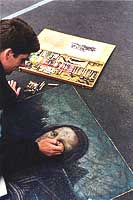The popular “three stroke” rule suggests that you can copy anyone’s art as long as at least three brush strokes are different.
No, that is NOT a law.
In fact, even within clear copyright law, every legal case will return a different decision.
My background in copyright law
 I’m not a lawyer, so this is opinion and based only on personal experience.
I’m not a lawyer, so this is opinion and based only on personal experience.
When I worked as an editor at M.I.T., I often helped professors rewrite portions of their own textbooks for publication elsewhere.
And, since the textbook publisher (not the author/professor) often held the copyright, I had to be sure that the professor wasn’t plagiarizing his own work.
So, I spent several days with teams of attorneys, discussing just how many changes are necessary to avoid lawsuits.
And, even in publishing, there are no clear rules.
We settled on “three to five major changes, per page” as a cross-your-fingers guideline.
Since then, and for my own art, I’ve followed copyright cases closely.
Simplest answer: Use copyright-free materials
Working for M.I.T. – with its own team of lawyers – is different from being an artist on a limited budget. You probably don’t have the resources to consult an attorney, much less hire one if you’re sued for copyright violation.
This is one reason why, from time to time, I offer products & freebies for artists to use without those headaches.
It’s also why, in the past, I’ve organized tours to popular (and picturesque) European destinations: So you can take copyright-free photos for use in your art.
Don’t make copies
Basically, you can’t copy someone else’s work (art, music, writing, etc.) in a way that deprives him or her of income that would otherwise go to that person. So, a “knockoff” is illegal.
Photocopying or otherwise reproducing someone else’s art/images to avoid buying a copy (or extra copies) is also illegal. (For personal use – for example if you want to photocopy part of a book that you own, to keep copies of those pages in a reference notebook for your own use – you can sometimes photocopy others’ work.)
Reproducing others’ art online (without permission) is very definitely a copyright violation, unless the art is old enough to be in public domain. (But, if you’re posting someone else’s photo of the art, the photo itself may still be protected by copyright. Again, the tours I’m scheduling will include museums, so you can take your own photos for use in your art.)
Additional opinions
- Protecting your art, online –
http://www.rightsforartists.com/copyright.html
Copyright, in general and online –
http://www.templetons.com/brad/copymyths.html
Copyright and collage
Collage is where the debates get heated.
If you use an item that you purchased in a collage that you sell, and there was a copyright notice on it, the copyright notice needs to remain visible, if possible. You may also choose to document the sources of the images in your collages, on the back of the work. (I generally don’t, but I may in the future, if only for my own reference.)
And, some artists will argue that you can’t use any copyrighted material in your collages, even an original item that you purchased. I’m not sure that I fully agree with this, but I recommend reading this and checking with an attorney if you are very concerned about this.
Every artist – especially those of us who aren’t lawyers – will interpret the law differently.
Many attorneys (and even judges) will disagree with each other, too.
We’ve all seen collages in artists’ published journals and diaries, and some of them feature copyrighted materials.
The days of Andy Warhol’s free use of the Campbell’s soup can… well, that’s ancient history.
But, copyright can be less of an issue when the individual copyrighted image is a small part of a larger work. Nobody can give you a firm rule about this, not even attorneys; use common sense.
Also see Copyright law and art – Just my non-legal opinion for collage & assemblage artists.
Fabric in art that you sell
Likewise, fabric designs are copyrighted too… but I’m not going to hand-paint every piece of fabric that goes into my quilts and other fabric art that I sell.
So, yes, my collages – paper and fabric art – include material copyrighted by others. I try to be careful about reproduction rights, but I’m less anxious about the original work, especially if I’m not creating it to sell.
Then again, if you make clothing, accessories, or even dolls from a commercial pattern and sell the finished item, you can sometimes get into trouble.
Many pattern companies specifically state whether you can sell items made from their patterns. Check the fine print.
Is this sounding confusing, murky, and just plain weird? Well, copyright laws ARE confusing, murky, inconsistent, vague… and sometimes weird!
Avoid the bulldogs!
Certain companies and estates are more watchful than others when it comes to copyright: The Elvis Presley estate, the Walt Disney company, National Geographic magazine, Sony, and Star Trek are among the more well-known copyright watchdogs. There are many others.
But, National Geographic was also sued by its own photographers when it reprinted past issues on CD-ROM, and used photos from those issues without the specific okay of the original photographers.
And, when Barbie owner Mattel sued artist Tom Forsythe over his “Food Chain Barbie” art, Forsythe won.
That said, Mattel still tries to shut down websites and artists who parody Barbie using the original dolls. If you can use any other doll for your parody art, avoid using Barbies and you’ll avoid lawsuits.
“Fair use” is not always an excuse
“Fair use” is a tangle. And, just because someone else gets away with “fair use”, doesn’t mean that you can use that same image without risks. The issue of willful intent and where the profits go, can make a big difference.
Link – http://fairuse.stanford.edu/commentary_and_analysis/2003_07_minow.html
The hazards of derivative works
“Derivative works” are also considered “transformative” and enter a truly gray area. But, if you’re obviously making money off someone else’s work, you’re risking lawsuit.
If you take a unique-to-one-artist concept, color scheme, or mimic someone else’s general style AND subject matter, you’re generally in “derivative” territory. How closely it matches the original, and which state you and the original artist live in, will determine whether or not a lawsuit would be successful.
Link – http://www.chillingeffects.org/derivative/
And, unless something is actually trademarked, you can copy the “look and feel” of someone else’s work with fewer worries.
Link – http://www.dreslough.com/dee/Legal/Primer1.html
“Stealing” ideas
On the other hand, ideas canNOT be copyrighted.
So, yes, if I talk about a book idea online and, say, Somerset Studio takes it and announces their own version of the exact same idea, I can’t do anything about it. Ideas -and book titles – cannot be copyrighted. (Sometimes they can be trademarked, which is a different topic. So is “intellectual property.”)
Parody is a very limited field
Parody is another blurry area. Sometimes, it’s similar to a kid who taunts a sibling and, when caught, tells his mom, “I was just kidding.” But, in other cases it’s clearly intended as parody, not to be confused with the original.
Link – http://www.chillingeffects.org/protest/faq.cgi#QID542
There’s also the question of celebrity images, privacy, First Amendment, and so on, such as the Winters brothers’ case.
In summary
Copyright is a confusing field for artist. The “three stroke” rule is practically an urban legend, not a law. You may need more changes – or less – to avoid copyright problems. It varies from work to work and case to case.
And, don’t forget that you can win in court and still lose your shirt in attorneys’ fees.
Personally, I’m careful about art that I sell or commercially reproduce, and generally shrug off worries when the art is for my own journal or other personal use.
My own resources
Remember, you can use artwork & photos I specifically create for reuse. (I’ll always make that clear, with whatever-it-is you’re downloading.) You can use those graphics in your art, even art that you sell.
Some other artists offer similar copyright-free images, but be sure to read the fine print before you buy or use those images. Be sure that there aren’t conditions that may limit their use.


 Every year, new art galleries and crafts shops open. Often, they’re launched on a shoestring.
Every year, new art galleries and crafts shops open. Often, they’re launched on a shoestring. If you want to meet other artists and talk with them about local resources and outlets for your own art, here’s one great approach: Join art associations and clubs, and — here’s the important part — go to their annual meetings.
If you want to meet other artists and talk with them about local resources and outlets for your own art, here’s one great approach: Join art associations and clubs, and — here’s the important part — go to their annual meetings. How do you choose a ‘good’ art show or crafts fair when you’re a beginner? A few simple cues can help you, plus one reliable source.
How do you choose a ‘good’ art show or crafts fair when you’re a beginner? A few simple cues can help you, plus one reliable source. Art fairs and art shows can be great or totally boring. What makes the difference? You do.
Art fairs and art shows can be great or totally boring. What makes the difference? You do. I’m not a lawyer, so this is opinion and based only on personal experience.
I’m not a lawyer, so this is opinion and based only on personal experience.